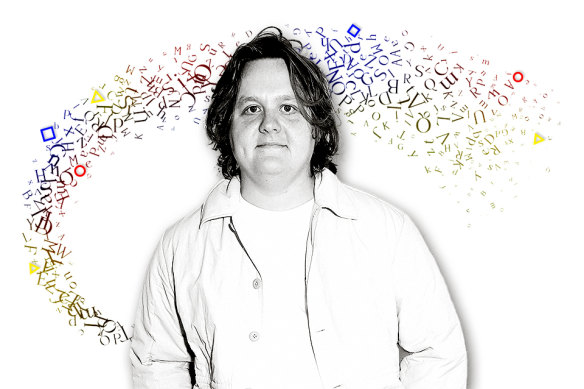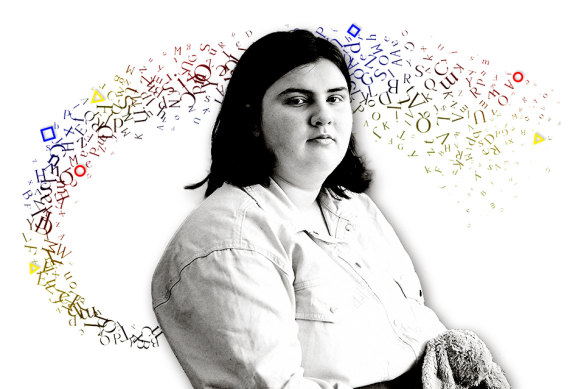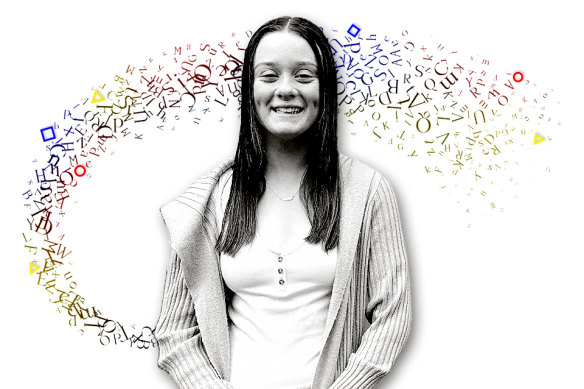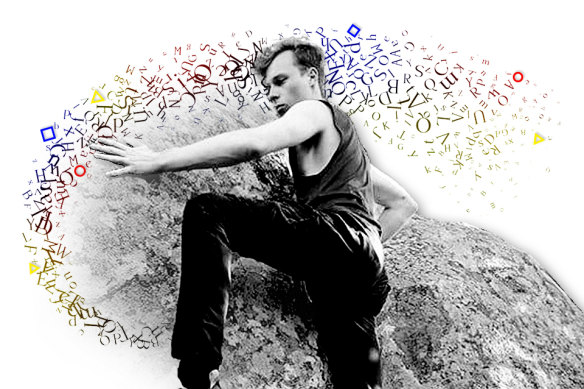Explainer
- Explainer
- Health
It starts as an itch then the urge grows: What’s it like to have Tourette’s?
Most people with Tourette’s actually don’t swear but their tics can be hard to control. Still, many succeed in reframing Tourette’s as just one part of who they are. What’s it like to live with this disorder?
Most of the time it’s like an itch. The urge increases until you scratch it. In some situations, holding it back can feel like being told not to press a big red button, so the need to press the big red button intensifies. This is how Tourette’s feels for James Sayers. He is sitting in his car explaining this to me. Then, mid-sentence, he sounds the horn, twitches in his seat and swears twice. “I just imagined my horn like the button,” he says. “And sure enough, I’m pressing it.”
His involuntary actions, called tics, happen in the blink of an eye. Other people with Tourette’s (also referred to as Tourette syndrome) describe the onset of tics as like a sneeze or a shiver. They can be routine or random, come and go with stress and fatigue, and involve anything from head nods or facial grimaces to grunts or words – but swearing occurs in only a handful of cases.
Sayers, 33, can temporarily tame his tics. Still, he does so knowing they “come out one way or another, like tenfold”. Tics usually develop in childhood and often wane as a person matures. Related mental health and neurodevelopmental disorders, as well as potential for bullying, can make school years particularly challenging. Year 12 was hardest for Sayers when he would involuntarily rip pages from textbooks and was diagnosed with depression.
Those whose symptoms continue into adulthood have often developed ways to work with the disorder so that they’re in charge of it, as much they can be. So, what’s it like to live with Tourette’s? What strategies do people with it use to lead successful lives, and how should you be with someone who has this disorder?

James Sayers: “If I call you bitch it means I love you because we’ve kind of turned it into something good.” Credit: Paul Jeffers. Artwork: Aresna Villanueva
What’s a tic? And what qualifies as Tourette syndrome?
The Parisian noblewoman known as the Marquise de Dampierre would abruptly yell curses and insults when in church, at the theatre or while out walking. Her mysterious case was first recorded in 1825 and discussed in medical papers and wider publications for decades. In 1885, shortly after her death, she became one of nine examples of what neurologist Georges Gilles de la Tourette called “maladie des tics”. Tourette never met the woman and his instructor, Jean-Martin Charcot, encountered her only in passing. Still, the case became “a sort of shorthand description … of the disorder itself”, notes Howard Kushner in his book A Cursing Brain? The Histories of Tourette Syndrome.
In fact, tics where people swear (called coprolalia from the Greek “faeces” and “speech”) affect only about 10 per cent of people with Tourette’s. Sayers has been yelling the word “bitch” for as long as he can remember. “It’s now part of my friendship group; if I call you bitch it means I love you because we’ve kind of turned it into something good.” Other forms of obscene, and rare, tics can include copropraxia: inappropriate actions or touching, and coprographia: inappropriate writing or drawing.
Far more common are motor tics: blinks and facial twitches, or jerks elsewhere in the body such as the neck. Tim Usherwood, a retired GP with Tourette’s, finds stressful situations cause him to twitch and shrug his shoulders, noticeable to friends, colleagues and patients. “I still have a wonderful life, and a fascinating and challenging career,” he says. “I see it as a part of who I am.” His vocal tics include grunting. Others with Tourette’s can sniff, cough, make high-pitched sounds or repeat words.

Academic and retired GP Tim Usherwood: “I still have a wonderful life, and a fascinating and challenging career.”Credit: Dominic Lorrimer. Artwork: Aresna Villanueva
Tics can shift over time and echo what people hear or see. After one English class in high school, Sayers could not stop saying “Macbeth”; then it was the name of ’80s funk icon Rick James. “There’s so many different [movie] character names I would have said in the past,” he says.
Many of our repeated actions and habits are not necessarily tics. “It will only be classed as a tic if the person has the feeling they are unable to control it,” says neuropsychiatry professor Perminder Sachdev, a founder of the Tourette Syndrome Association of Australia.
Tics usually develop from age four, are more common in boys, get worse between 10 and 12, and mostly wane in adolescence.
Tics usually develop from age four, are more common in boys, get worse between ages 10 and 12, and mostly wane in adolescence. One in eight schoolchildren will have a tic for less than a year. “It goes away [and] that’s much more common,” says Valsamma Eapen, head of child and adolescent psychiatry at UNSW Sydney. But tics last longer than a year for about one in 100 children. “Often you will start with a blink or a facial twitch then it spreads to other parts,” says Eapen. A diagnosis of Tourette’s is when the person has had at least one vocal tic and multiple motor tics for a year before they turn 18.
US pop superstar Billie Eilish was diagnosed with Tourette’s as an 11-year-old, and has described tics as “very exhausting”. On stage, intense focus means she does not experience them. Scottish singer Lewis Capaldi, diagnosed with Tourette’s as an adult, has experienced tics during performances. At the Glastonbury Festival this year, tics stopped him singing mid-song and the crowd helped him finish the tune. “I’m still learning to adjust to the impact of my Tourette’s,” he said afterwards, announcing he was cancelling an upcoming tour.
Adults can also be diagnosed with the condition if they have a history of tics stretching back to childhood or teen years. Another complication of diagnosis is people might not display tics on the day they see a clinician. “They wax and wane, new tics come all the time,” Eapen says. Doctors will ask parents for accounts of their child’s history or sometimes ask them to record videos. “Just because it’s not manifesting when we are consulting, or things are not there for a period of time, should not discount it.”

Singer Lewis Capaldi: “I’m still learning to adjust to the impact of my Tourette’s.”Credit: Getty Images. Artwork: Aresna Villanueva
What puts you at risk of Tourette’s, and what can come with it?
When Eapen met a 13-year-old girl this year whose Tourette’s had caused her to inappropriately touch her school teacher, it wasn’t the girl’s tics but her father raising his eyebrows she first noticed. He had a “kind of facial twitch”, she recalls. “And that was my clue that this was probably a tic family.”
Someone with a parent or sibling with Tourette’s is 18 times more likely to have the condition themselves. Mandy Maysey’s three sons all have Tourette’s. “I thought, ‘Oh my god, how did I manage to get three?’” says Maysey, president of Tourette Syndrome Association of Australia. “But actually, when you realise it is genetic, those odds are an awful lot more likely.”
There are three or four genes known to have a “robust” link to the condition, says Professor Peristera Paschou, a leading researcher into the genetics of Tourette’s from Purdue University in the US. But this is just a tiny part of a bigger puzzle. “It is totally feasible that we could be looking at 100 genes, of course each one of them contributing a small part of the risk.”
Between 50 and 60 per cent of people with Tourette’s also have ADHD or OCD. “We have indications to show that the genes that underlie Tourette plus ADHD are different from Tourette plus OCD,” Paschou explains. Professor of child psychiatry James Leckman, of Yale University, says people with tic-related obsessive compulsive disorders will often order things in symmetry so they “look or sound or feel just right” while those with ADHD show classic symptoms of difficulty focusing. “Almost all children I see have some degree of attentional difficulties, have some degree of obsessive compulsive behaviours,” he says.
Genes involved in the immune system have also been linked to Tourette’s, opening possibilities for how environmental factors interact with genes. “Of course, we don’t yet know for sure,” Paschou says. Pregnancy complications such as hypertension, infections, psychosocial stress, preeclampsia or diabetes are linked to children having greater tic severity, several studies suggest. So while we either carry genes or not, “these stressors in pregnancy just increase that likelihood [of a child having Tourette’s] a little bit more,” says Professor Russell Dale, clinical director of Sydney’s Kids Neuroscience Centre.

Kai Gardner: “If people are laughing ... I get self-conscious.” Credit: Justin McManus. Artwork: Aresna Villanueva
What’s happening in the brain of someone ticcing?
At the Johns Hopkins Tourette Centre in the US, co-director Harvey Singer uses the image of a race circuit to explain to families what could be happening in the brain of his patients. “The problem could be at the start of the race, or the quarter pole or down the finish,” he says. The car passes the frontal cortex to areas with Latin and Greek names deeper in the brain (such as the striatum, globus pallidus, thalamus) before racing back to the cortex. “We don’t know for sure which it is.”
The reality is much more complex: brain studies have located neural pathways such as a habitual behavioural circuit, a goal-directed circuit and an emotion-related circuit that could be involved. “These pathways are fascinating but complex; it is not as simple as this flows to that. They are multi-connected with inputs from lots of different structures,” Singer says. An imbalance of neurotransmitters, particularly of dopamine, is also implicated, but whether these are a cause or symptom is unclear.
Most of the activity in our brains can be thought of as taking place behind a gate that keeps it from entering our conscious minds. But people with Tourette’s, Eapen says, could be thought of as having a “leaky gate” where “a little bit of that comes to your conscious awareness”. This awareness – what people with Tourette’s compare to the urge to itch or sneeze – is known as a premonitory sensation. “You then respond to it with a motor action,” Eapen says. “It’s almost like the movements are released from the subcortical structures without the checks and balances.”
Eapen cautions against interpreting tics as revealing what the person actually believes, even in the rarer cases where a tic is a response to their environment. Someone with Tourette’s could call someone who is overweight “fat”, for example, but this impulse is out before they’re conscious of it. On the rare occasion Sayers blurts out something offensive he can’t control, he explains it this way: “It’s like a bad thought without bad intentions.” (Eapen prefers the term involuntary vocalisation: “It is without thought or intention.” )
Our brains are not fully developed until our mid-20s, yet tics remain for a substantial number of people with Tourette’s into adulthood while between about a third and a half of cases report remission. “That’s because a lot of compensatory circuitry comes to your rescue as the brain matures,” says Eapen.

One of Jack Van Hees’ tics is saying “blue square, red circle, yellow triangle” instead of swearing.Credit: Artwork: Aresna Villanueva. Photo: Supplied
What are the treatments for Tourette’s?
The first tic Jack Van Hees noticed felt like a shiver. He was in primary school and his neck would jerk to the left when he was cold or when he felt socially uncomfortable. Then one day, as a teenager, the tic began to repeat over and over along with words such as “drip” and swear words. “I think there’s a part in the brain where all of these funny words and bad words are stored [where] for some reason the Tourette’s just loves to play,” says Van Hees.
A psychologist introduced the then 16-year-old to behavioural therapy. The therapy aims to raise awareness among patients of the premonitory urge to tic. “It’s training them to catch it,” Eapen says. Once aware of the urge, people try a competing action: contracting muscles at the back of the neck when there is an urge to move their jaw, squeezing their fingers when they feel like jerking their shoulder. Behavioural therapy is helpful in up to half the cases.
Van Hees says he was “very unreceptive” to the treatment. “They didn’t know what it felt like,” he says. But something sunk in, and he taught himself to say “blue square, red circle, yellow triangles” every time he felt the urge to curse. “I can kind of move the energy somewhere else,” he says. “Or it might even be a movement – I’ll try to hold the noise, and I’ll turn that into a body tic.” The now 21-year-old still says the names of shapes and colours, and has a tattoo of a blue square. “It reminds me of where I came from,” says Van Hees.
In cases where tics are severely disrupting the patient’s life or causing pain, clinicians will offer medication which, Eapen says, can be effective in about 60 to 70 per cent of patients. “It’s more trial and error,” she says of finding a successful drug or dosage. Drugs useful in improving attention and impulse control, such as clonidine and guanfacine, are often a first option, especially in children also with ADHD. Clinicians can prescribe antipsychotics, such as those that target dopamine receptors, but these can bring greater side effects.
In rare cases the patient can receive deep brain stimulation. Surgeons implant electrodes into certain parts of the brain controlled by a device similar to a pacemaker to regulate abnormal impulses. “Obviously, you don’t want to go there unless you really have failed all these other approaches,” says Singer. Sayers considered the surgery but decided against it. “[Tourette’s] is part of who I am; life can be hard, but it’s what we make of it,” he says.

Caitlyn Quinn: “I just wish that people would understand how people with Tourette’s feel.”
What’s it like to live with Tourette’s?
The closest friend to Caitlyn Quinn who also has Tourette’s is a more than two-hour drive from her home in Rochester, in central Victoria. “I just wish that people would understand how people with Tourette’s feel,” she says. Caitlyn, 14, has been living with her family in a repurposed shed since floods devastated the town in October last year. The disruption to routine has made her tics worse, as did being housebound during the pandemic. “I can barely sit at home on weekends. I have to be doing something,” she says.
Bullying at school has been worse this year. Her mother, Ingrid, believes the behaviour is related to young people feeling out of whack after the floods. The bullies will sometimes whistle – a trigger that sets off a tic where Caitlyn punches herself. “It’s kind of like when somebody punches somebody [else],” Caitlyn says. Like any teenager, she just wants to fit in. “I have a few good friends who don’t really care about it, and just treat me like I am a normal kid.” She hopes to be a teacher or a doctor one day. “I want to help other people; with Tourette’s, or just anything.”
‘If I found it funny, then, like, it’s OK [to laugh]. If people are laughing anyway, I get self-conscious.’
Tics that cause self-injuries are rare, appearing in 5 per cent of cases. Kai Gardner, 15, has been hospitalised several times after involuntary movements. (In 2021-22, 42 people were admitted to hospitals in Australia as a result of Tourette’s.) Kai’s injuries have been to her back and tendons, and stomach muscles. Bruises often appear where she has punched herself. Sometimes the tics cause her to hit other people in public. “I always respond with, ‘Sorry’ and, ‘I can’t help it. I have Tourette’s, I can’t control what I do.’”
Some develop a thick skin to the glances that come while ticcing in public as they mature. “If you worry about everyone’s opinion all the time, it’s going to drive you insane,” says Sayers. Kai, who lives in Melbourne’s suburban west, often worries what others are thinking, especially if they laugh. “If I found it funny, then, like, it’s OK [to laugh],” she says. “If people are laughing anyway, I get self-conscious.” In an interview with David Letterman, Eilish said the most common reaction when she tics is laughter. “They think I’m, like, trying to be funny,” Eilish said. “I’m always left incredibly offended by that.” In a later interview, she said while her friends knew she had Tourette’s she hadn’t wanted it to define who she was. Since publicly revealing her diagnosis, she’d “learned that a lot of my fans have it, which made me feel kind of more at home”.

Rock climbing temporarily halts tics for Jack Van Hees: “I feel like I know every inch of myself.”
Usherwood, 69, says Tourette’s makes him hyper-aware of others ticcing, and the possibility of copying others’ tics. “Occasionally, that’s led me to leave a room or a railway carriage,” he says. “I was concerned that I might start to copy them and be thought to be making fun of them.” The Tourette Syndrome Association hosts camps around Australia where groups of people with the condition and their families hear from experts and role models, do quiz nights, talent shows, ropes courses, rock climbing – and generally feel free from judgement. “It means they can tic away, be themselves. They can be around other people who know exactly what’s going on,” says Maysey, the association’s president. “It gets louder and louder and the tics compete.”
‘When I rock climb I find the tics disappear, but when I get to the top I have to release them.’
As with many older people with Tourette’s, Sayers has found his own way to temporarily control tics: drumming in a heavy metal band. “If I do a show, start to finish, no tics,” he says. “I have involuntary movements but as a drummer it’s the exact opposite; I’m the one that keeps the time. I can’t explain it, it’s just that euphoric feeling, whereas for someone else it mightn’t be music.” Usherwood has enjoyed climbing for a similar reason. “When I rock climb I find the tics disappear, but when I get to the top I have to release them,” he says. Van Hees and Sayers, a gym coach of 15 years, both enjoy climbing too. “I feel like I know every inch of myself and I can control it better,” says Van Hees. Directing attention away from tics might improve the signal-to-noise ratio in the motor system, says Eapen. “Your attention is diverted away from executing anything else.”
Kai enjoys playing tennis but on court the tics can worsen. At home, she enjoys writing fan fiction, and when she does the tics disappear: “My imagination and my mind are on that. I get really involved.” In her first year of high school, she made posters of an iceberg as a way to explain to students and teachers that tics are only the visible surface of life for someone with Tourette’s. “The top bit was Tourette’s, the bottom was all the bits that come with it – ADHD, anxiety, and it also said bruises and pain,” she says. “I was the only one in school with actual Tourette’s. And I felt a bit left out and that no one really understood.”
Kai also has several other neurodevelopmental disorders and is now home-schooled. She says this is the best option for her after having severe full-body tics at school. But before she left school, two boys asked her about the poster. “They actually really wanted to understand what Tourette’s is ... They wanted to know more – and not just about what everyone expects.” As she recounts this, her eyes light up, her voice now racing. “And I told them a few things.”
Fascinating answers to perplexing questions delivered to your inbox every week. Sign up to get our Explainer newsletter here.
Let us explain
If you'd like some expert background on an issue or a news event, drop us a line at explainers@smh.com.au or explainers@theage.com.au. Read more explainers here.